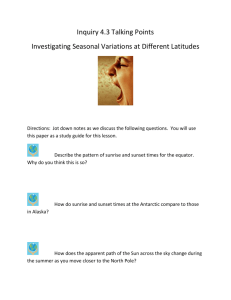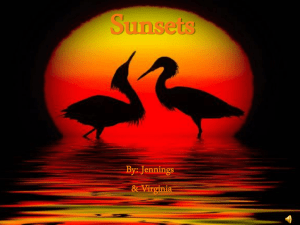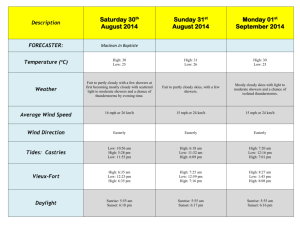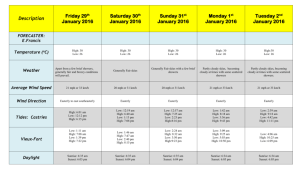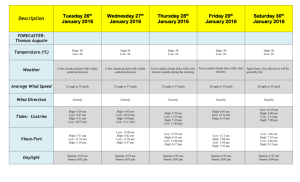Sunset OWL Chart
advertisement
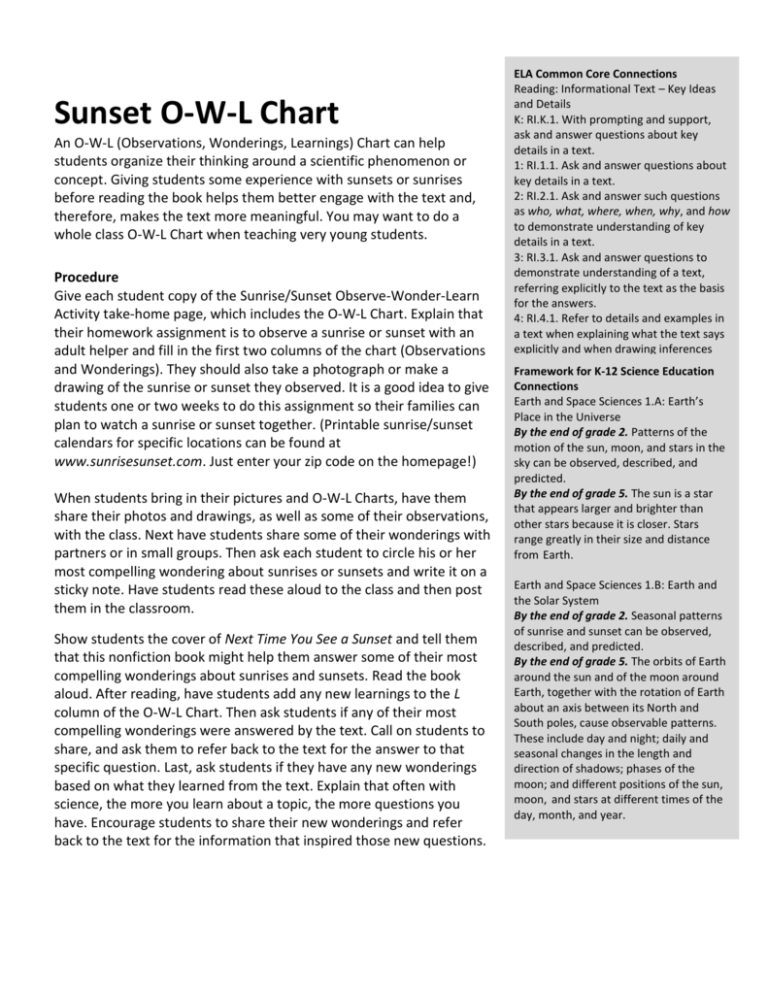
Sunset O-W-L Chart An O-W-L (Observations, Wonderings, Learnings) Chart can help students organize their thinking around a scientific phenomenon or concept. Giving students some experience with sunsets or sunrises before reading the book helps them better engage with the text and, therefore, makes the text more meaningful. You may want to do a whole class O-W-L Chart when teaching very young students. Procedure Give each student copy of the Sunrise/Sunset Observe-Wonder-Learn Activity take-home page, which includes the O-W-L Chart. Explain that their homework assignment is to observe a sunrise or sunset with an adult helper and fill in the first two columns of the chart (Observations and Wonderings). They should also take a photograph or make a drawing of the sunrise or sunset they observed. It is a good idea to give students one or two weeks to do this assignment so their families can plan to watch a sunrise or sunset together. (Printable sunrise/sunset calendars for specific locations can be found at www.sunrisesunset.com. Just enter your zip code on the homepage!) When students bring in their pictures and O-W-L Charts, have them share their photos and drawings, as well as some of their observations, with the class. Next have students share some of their wonderings with partners or in small groups. Then ask each student to circle his or her most compelling wondering about sunrises or sunsets and write it on a sticky note. Have students read these aloud to the class and then post them in the classroom. Show students the cover of Next Time You See a Sunset and tell them that this nonfiction book might help them answer some of their most compelling wonderings about sunrises and sunsets. Read the book aloud. After reading, have students add any new learnings to the L column of the O-W-L Chart. Then ask students if any of their most compelling wonderings were answered by the text. Call on students to share, and ask them to refer back to the text for the answer to that specific question. Last, ask students if they have any new wonderings based on what they learned from the text. Explain that often with science, the more you learn about a topic, the more questions you have. Encourage students to share their new wonderings and refer back to the text for the information that inspired those new questions. ELA Common Core Connections Reading: Informational Text – Key Ideas and Details K: RI.K.1. With prompting and support, ask and answer questions about key details in a text. 1: RI.1.1. Ask and answer questions about key details in a text. 2: RI.2.1. Ask and answer such questions as who, what, where, when, why, and how to demonstrate understanding of key details in a text. 3: RI.3.1. Ask and answer questions to demonstrate understanding of a text, referring explicitly to the text as the basis for the answers. 4: RI.4.1. Refer to details and examples in a text when explaining what the text says explicitly and when drawing inferences from the text. Framework for K-12 Science Education 5: RI.5.1. Quote accurately from a text Connections when explaining what the text says Earth and Space Sciences 1.A: Earth’s explicitly and when drawing inferences Place in the Universe from the text. By the end of grade 2. Patterns of the motion of the sun, moon, and stars in the sky can be observed, described, and predicted. By the end of grade 5. The sun is a star that appears larger and brighter than other stars because it is closer. Stars range greatly in their size and distance from Earth. Earth and Space Sciences 1.B: Earth and the Solar System By the end of grade 2. Seasonal patterns of sunrise and sunset can be observed, described, and predicted. By the end of grade 5. The orbits of Earth around the sun and of the moon around Earth, together with the rotation of Earth about an axis between its North and South poles, cause observable patterns. These include day and night; daily and seasonal changes in the length and direction of shadows; phases of the moon; and different positions of the sun, moon, and stars at different times of the day, month, and year. Sunrise/Sunset Observe-Wonder-Learn Activity Dear Parent, At school, we are studying Earth’s patterns and cycles. Your child’s homework assignment is to go outside with an adult helper and observe a sunset or a sunrise. As you look at the sky with your child, help him or her record “Observations” and “Wonderings” (questions) on the attached chart. Also, have your child either take a photograph or draw a picture of the sunrise or sunset. Below is a list of items to bring outside with you and some tips on making the most of this experience. The purpose of this assignment is to give your child the opportunity to observe this daily phenomenon firsthand and wonder about it. In class, we will be building on this experience by reading about it and modeling the Earth and Sun relationship. This assignment is due by __________________________ . Items to bring: O-W-L Chart Flashlight Clipboard or notebook Camera or art supplies Pen or Pencil Sunrise/sunset viewing tips: 1. Do not look directly at the sun. Sunlight can cause eye damage. 2. Find a place, without a lot of trees or buildings, where there is a clear view of the eastern sky (sunrise) or western sky (sunset). Be sure to bring a flashlight with you so you can find your way before sunrise or after sunset. 3. Watch the colors of the sky change. Discuss what colors you see, how the temperature of the air feels, and how your shadows look. Share your ideas and wonderings about what is happening. Child: _______________________ Adult helper: _______________________ Date: ________ Time: __________ Instructions: Take a photograph or draw or paint a picture of the sky. Give your picture a title and attach it to this page. Record your observations and wonderings (questions) in the chart. O W L Observations Wonderings Learnings
